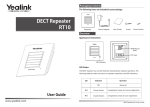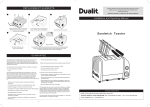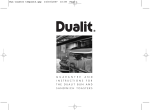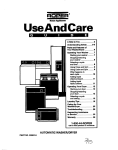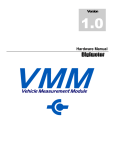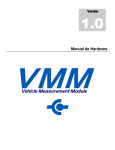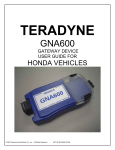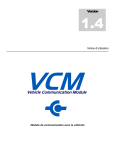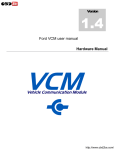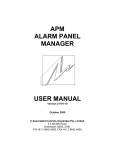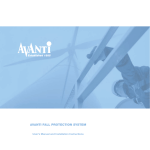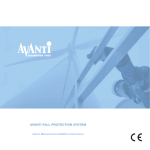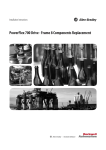Download Installation Manual
Transcript
Installation Manual Two-Post Lift 9,000lbs. Capacity OPERATING CONDITIONS )-0/24!.4 Reference ANSI/ALI ALIS, Safety Requirements for Installation and Service of Automotive Lifts before installing lift. Lift is not intended for outdoor use and has an operating ambient temperature range of 41°-104°F (5°-40°C) LP50029 IN50029Rev. © January 2013 by Vehicle Service Group. All rights reserved. CO8325.3 1/8/2013 F E G H A I B C Fig. 1a D 28" MIN ARM REACH 41 1/2" MAX ARM REACH J K 30 1/2" MIN ARM REACH Fig. 1b 44 3/4"MAX ARM REACH L L 2 1. Lift Location: Use architects plan when available to locate lift. Fig. 1a & Fig. 1b shows dimensions of a typical bay layout. WARNING DO NOT install this lift in a pit or depression due to fire or explosion risks. A B C D E F G H I J K L POWER UNIT HEIGHT LIFTING HEIGHT W/ 5" EXTENSION MIN. LIFT HEIGHT MIN. LIFT HEIGHT W/ 1 3/4" ADAPTER 72-1/2" 76-5/8" W/ 68" STROKE 3-5/8" 5-3/8" MIN. LIFT HEIGHT W/ 5" ADAPTER OVERALL FLOOR WIDTH INSIDE COLUMNS 8 5/8" 132" 109" WIDTH BETWEEN CARRIAGES HEIGHT OVERALL MIN. FLOOR CEILING HEIGHT FLOOR TO OVERHEAD SWITCH DRIVE THRU CLEARANCE MINIMUM TO NEAREST OBSTRUCTION MINIMUM TO NEAREST OBSTRUCTION MINIMUM TO NEAREST OBSTRUCTION 107" 142" 144" 137-5/8" 99" 132" 156" 72" NOTES: 1.) ALL HEIGHT DIMENSIONS ARE WITHOUT LEVELING SHIMS. 2.) STANDARD HEIGHT LIFT SHOWN. 3.) “ ANCHORING SYSTEM TESTED TO ANSI/ALI ALCTV 2006. LIFT CAPACITY LIFTING SPEED (RISE TIME) 9,000 LBS. APPROXIMATELY 45 SECONDS UNLOADED APPROXIMATELY 51 SECONDS AT RATED CAPACITY SINGLE PHASE 208-240V 50-60Hz 18-23 AMPS MOTOR RATING OPTIONS 3 PHASE 208-230/460V 50-60Hz 17/8.5-14/8 AMPS WEIGHT 1500 LBS MECHANICAL SAFETY LOCKS AUTOMATIC ALL POSITIONS MECHANICAL SAFETY RELEASE MANUAL ALL BOTH COLUMNS SWING ARM LOCKS AUTOMATIC LOCKING ABOVE 2 1/2" HYDRAULIC SAFETY SYSTEM AUTOMATIC ALL POSITIONS CYLINDERS TWO, ONE PER COLUMN CARRIAGE BEARINGS EIGHT PER CARRIAGE, UHMW SYNCHRONIZATION EQUALIZATION CABLES MIN. BAY SIZE 12' X 24' VERIFY WITH SITE PLAN & SERVICE VEHICLES 3 2. Power Unit Tee Cover Plate: While power unit column is laying on the ground, install the cover plate using (2) M4x6 Lg. PHMS Fig. 2. M4x6 Lg. PHMS 3. Hoses: Clean adapters and hose. Inspect all threads for damage and hose ends to be sure they are crimped. Flared Fittings Tightening Procedure 1. Screw the fittings together finger tight. Then, using the proper size wrench, rotate the fitting 2-1/2 hex flats. Fig. 2 IMPORTANT Flare seat MUST NOT rotate when tightening. Only the nut should turn. 2. Back the fitting off one full turn. 3. Again tighten the fittings finger tight; then using a wrench, rotate the fitting 2-1/2 hex flats. This will complete the tightening procedure and develop a pressure tight seal. 4. Power Unit Tee: With the column still laying on the ground push the lift carriage as high as possible to install the power unit tee. Once carriage is rasied, install the power unit tee and hoses to the column Fig. 3. CAUTION Overtightening will damage fitting resulting in fluid leakage. CAUTION Overtightening will damage fitting resulting in fluid leakage. CAUTION Over tightening locknut may tear O-ring or distort threads in pump manifold outlet. Hydraulic Hose Fig. 3 Power Unit Tee Carriage 4 5. Column Extensions: Install the column extensions using (2) 1/2”-13NC x 1 1/4” Carriage HHCS and Nylon Locknuts, Fig. 4. 7. Latch Cable Guides: Install the latch cable conduit guide brackets to column extensions with (1) 1/4”20NC x 1” HHCS and 1/4”-20NC Flanged Locknuts, HHCS should go through hole nearest the edge as shown, Fig. 6. 8. Lift Setting: Position columns in bay using dimensions shown in Fig. 1a & Fig. 1b. Place column with power unit mounting bracket on vehicle passenger side of lift. Both column base plate backs must be square on center line of lift. Notches are cut into each base plate to indicate center line of lift. Use appropriate equipment to raise carriage to first latch position. Be sure locking latch is securely engaged. Fig. 4 1/2”-13NC Nylon Locknut & 1/2” Flat Washer Fig. 6 1/2”-13NC x 1-1/4” HHCS & 1/2” Flat Washer 6. Reinforcement Bar: Install the reinforcement bar to the column and column extension using (2) 1/2”-13NC x 1-1/4” HHCS, (4) 1/2” Flat Washer, and (2) 1/2”-13NC Nylon Locknut Fig. 5. 9. Cylinder Fitting/Flow Valve: Push the carriage to first lock and then install the flow valve and 90° elbow to the cylinder through the small opening on the bottom of the column. Fig 7. Fig. 5 CAUTION Overtightening will damage fitting resulting in fluid leakage. 1/2”-13NC x 1-1/4” HHCS & 1/2” Flat Washer 1/2”-13NC Nylon Locknut & 1/2” Flat Washer Fig. 7 5 Flow Valve Body 90° Elbow 10a. Overhead Assembly: Fig. 9: Adjust overhead to appropriate dimension. Install (4) 3/8”-16NC x 3/4” HHCS & 3/8”-16NC Flanged Locknuts, do not tighten. Slide Switch Box over switch bar ensuring knock out holes face the power unit column. Use (2) 1/4”-20NC x 3/4” lg. HHCS, 1/4” Flat Washer, and 1/4”-20NC Nuts to mount switch box to overhead, see Fig. 8. Fig. 8 10b. Continued Overhead Assembly: For single phase lifts: Insert 1/4”-20NC x 2 3/4” HHCS through pivot hole in end of switch bar. Insert opposite end of bar through slot in switch mounting bracket. Then secure HHCS and Switch Bar to overhead as shown, Fig. 9, using (2) 3/4” spacers and 1/4”-20NC Locknut. Tighten Hex bolt leaving 1/16” gap between the spacer and the overhead assembly. 7 3/4" Standard M10-1.5 x 20mm HHCS & Flanged Locknut 108" Standard Open Bar Side Switch Box Side Fig. 9 1/4" Lock Nut 1/4" Lock Nut 2 Spacers 1/4" Flat Washer 1/4"-20NC x 2 3/4" HHCS 1/4"-20NC x 3/4" HHCS 6 For three phase lifts: Remove Limit Switch cover, Fig. 10. Insert Actuator end of Switch Bar into slot located inside Limit Switch, Fig. 10. A small amount of silicone sealant on the lower part of the actuator will help hold it in place. Insert 1/4”-20NC x 2 3/4” HHCS through pivot hole in end of Switch Bar. Then secure HHCS and Switch Bar to overhead as shown, using (2) 3/4” spacers and 1/4”-20NC Locknut. Tighten Hex bolt leaving 1/16” gap between the spacer and the overhead assembly, Fig. 9. Replace limit switch cover. Use M10-1.5 x 20mm HHCS and Locknuts Fig. 11 Fig. 10 12. Power Unit: First install a star washer onto all of the (4) 5/16”-18NC x 1-1/2” HHCS. This is very important for grounding. Put the (4) 5/16”-18NC x 1-1/2” HHCS thru holes in power unit bracket, Fig. 12. Mount unit with motor up to column bracket and install (4) 5/16” star washers and 5/16” Nuts. Install and hand tighten fitting to pump until O-ring is seated. Continue to tighten the locknut until the nut and washer bottom out against the pump manifold. Remove Screws And Cover Place Actuator Here. A Small Amount Of Silicone Sealant On The Lower Part Of The Actuator Will Help Hold It In Place. Cradle Bar On Actuator NOTE: You may still be able to rotate the fitting. This is acceptable unless there is seepage at the O-ring. If so, slightly tighten the locknut. Actuator Use (4)5/16"-18NC x1-1/2" lg. HHCS and Nuts Fig. 12 11. Overhead Installation: Install overhead assembly to Mounting Bracket with (2) M10-1.5 x 20mm HHCS, and (2) M10-1.5 Flanged Locknut Fig. 11. Tighten bolts at center of overhead assembly. On all four bolts, place (2) 5/16" Star Washers Fill Breather Cap 7 13. Adapter & Hose Installation (see Fig. 14) 1. Connect the free end of the second shortest hose Pc. (2), from paragraph 3, to the power unit side cylinder Pc. (1). Run hose through channel inside column. 3. Run the free end of the longest hose Pc. (3), from paragraph 3, through hose clamps Pc.(9), and channel. Then connect it to the slave side cylinder. 4. Take the end of the remaining hose Pc. (4) out of the column and connect it to the fitting on the power unit Fig. 13. Cylinder Bleeders 6 Hose runs down approach side to cylinder on left column. 3 NOTE: Overhead hose goes over top end of overhead assembly, Fig. 14 & Fig. 18a & Fig. 18b. 4 5 FRONT 2 1 Fig. 14 7 Fitting 8 ITEM 1 2 3 4 5 6 Power Unit Hose Fig. 13 7 8 8 QTY. 2 1 1 1 1 2 2 2 2 2 DESCRIPTION Hydraulic Cylinder Cylinder Hose Slave Side Hose Power Unit Hose 3/8” Branch Tee Hose Clips M10-1.5 x 20mm HHCS M10-1.5 Flanged Locknuts 90° Fitting Flow Control Valve 14. Equalizing Cables A) Refer to Fig. 16 for the general cable arrangement. B) First, run a cable end up through the small hole in the tie-off plate. Fig. 17. C) Push the cable up until the stud is out of the carriage top opening. D) Run a nylon insert locknut onto the cable stud so 1/2” (13mm) of the stud extends out of the locknut. E) Pull the cable back down, Fig. 17. F) Run cable around the lower sheave, then up and out of the top of the column. G) Run cable around overhead sheave and across and down to the opposite carriage. Install sheave cover, Fig. 15. H) Fasten the cable end to the carriage upper tie-off bracket, Fig. 17. Tighten the locknut enough to I) Adjust the tension of both cables during the final adjustments in Paragraph 24. Upper Sheaves 2nd Cable Fig. 16 1st Cable Lower Sheaves Uper Cable Tie Off & 5/8" Nylon Insert Locknut Fig. 15 Sheave Cover Fig. 17 Lower Cable Tie Off & 5/8" Nylon Insert Locknut 9 F) Bring the cable down inside the left column and feed the end of the cable through the lower latch cable sheave slot so that the cable is now back outside the column, Fig. 21. G) Route cable under the bottom side of the latch cable sheave, Fig. 21. H) At this point you MUST install the latch handle, jam nut, and right column latch cover Fig. 19 & Fig. 22. Install latch handle ball, Fig. 22. I) Insert cable in cable clamp along one side, loop around shoulder screw and back down, inserting cable along other side of cable clamp, Fig. 21. Place top back on clamp, barely tightening. J) Next, pull the control plate down, Fig. 20 & Fig. 21, to eliminate any clearance between the control plate slot and the latch dog pin, Fig. 20. K) Using Pliers, pull cable tight and secure the clamp close to the shoulder screw. Tighten clamp. 15. Locking Latch Cable A) Slip loop end of cable over end of shoulder screw on right side latch control plate, Fig. 19. B) Feed the other end of the cable through the latch cable sheave slot making sure that the cable is running under the bottom side of the latch cable sheave and inside the right column, Fig. 19. C) Attach latch cable conduit guide brackets to overhead as shown, Fig. 18a & Fig. 18b. Always use the holes on the approach side of the lift. HHCS should be in hole nearest the center of the overhead, Fig. 18b. D) Route cable up inside column and through the latch cable guide, Fig. 18a & Fig. 20. IMPORTANT Using wire ties provided, tie off hydraulic hose snug to cylinders to keep hose away from equalizing cable, Fig. 14. E) Continue routing cable to the left column latch cable guide, Fig. 18a & Fig. 20, routing the cable through the left column latch cable guide, Fig. 18a. Cable Guide runs UNDER hydraulic hose Cable Guide does not cross hydraulic hose M10-1.5 x 20mm HHCS and Flanged Locknut M10-1.5 x 20mm HHCS and Flanged Locknut 1/4"-20NC x 1" HHCS and Flanged Locknut 1/4"-20NC x 1" HHCS and Flanged Locknut Fig. 18a Attach Hose Clamps Here Attach Latch Cable Conduit Guide Bracket Here. Always use two holes on approach side of extension to attach bracket. APPROACH Always put HHCS through hole closest to center of overhead. Fig. 18b 10 Latch Cable Sheave (2) 3/8" Retaining Rings Fig. 19 Shoulder Bolt Install Latch Handle using a 3/8" hex jam nut to lock in place. Then install flat washers and slot cover. ,ATCH#ABLE'UIDE ,ATCH#ABLE Fig. 20 .OTICETHECLEARANCE REMOVEDBETWEEN #ONTROL0LATE3LOT AND,ATCH$OG0IN (3) 3/8” Flat Washers Slot Cover 2IGHT#OLUMN Shoulder Bolt Feed cable up through Cable Clamp, loop over end of shoulder bolt and feed back down through Cable Clamp. Cable Clamp Latch Cable Sheave Fig. 21 (2) 3/8" Retaining Rings 5/16-18NC x 3/8" lg. PHMS Latch handle MUST be positioned at the top of the latch control cover. 11 Ball Handle Fig. 22 Recheck columns for plumb. Tighten anchor bolts to an installation torque of 110 ft-lbs. Shim thickness MUST NOT exceed 1/2” when using the 5-1/2” long anchors provided with the lift, Fig. 23. Adjust the column extensions plumb. 16. Concrete and Anchoring: Drill (10) 3/4” dia. holes in concrete floor using holes in column base plate as a guide. See Fig. 24 for hole depth, hole spacing, and edge distance requirements. CAUTION DO NOT install on asphalt or other similar unstable surfaces. Columns are supported only by anchors in floor. If anchors do not tighten to 110 ft-lbs. installation torque, replace concrete under each column base with a 4’ x 4’ x 6” thick 3000 PSI minimum concrete pad keyed under and flush with the top of existing floor. Let concrete cure before installing lifts and anchors. IMPORTANT Using the horse shoe shims provided, shim each column base until each column is plumb. Anchor Nut Flat Washer Fig. 23 Shims (1/2" Max.) NOTE: Use rectangular shims at inside edge of baseplate. Use constructions adhesive or silicon cement to hold shim in place. INSURE shims are held tightly between base plate and floor after torquing anchors. NOTE: If more than 2 horse shoe shims are used at any of the column anchor bolts, pack non-shrink grout under the unsupported area of the column base. Insure shims are held tightly between the baseplate and floor after torquing anchors. 12 Fig. 24 Drill holes using 3/4” carbide tipped masonry drill bit per ANSI B212.15-1994 (R2000) Clean hole. Run nut down just below impact section of bolt. Drive anchor into hole until nut and washer contact base. Tighten nut with Torque wrench to 110 ft.-lbs. CONCRETE AND ANCHORING REQUIREMENTS STANDARD ANSI/ALI ALCTV IBC 2006, 2009, 2012 Minimum Floor Thickness 4-1/4 INCHES 5 INCHES Anchor Hilti HIT-HY 150 Hilti Kwik Bolt III MAX-SD Adhesive; 3/4" x 7" Hilti HIT-HY 150 MAX Adhesive; HILTI HIT-RE 500SD Adhesive Minimum Concrete Strength Hilti Kwik Bolt III 3/4" x 5-1/2" Anchors supplied with the lift.* 3000 PSI 6 INCHES 3000 PSI 3000 PSI Minimum Anchor Embed- 3-1/4 INCHES ment 3-1/2 INCHES 3-3/4 INCHES Minimum Distance to Concrete Edge, Crack, Expansion Joint, Abandanoned Anchor Hole 5-1/4 INCHES 3-1/4 INCHES 4-1/2 INCHES *The supplied concrete fasteners meet the criteria of the American National Standard “Automotive Lifts - Safety Requirements for Construction, Testing, and Validation” ANSI/ALI ALCTV-2011, and the lift owner is responsible for all charges related to any additional anchoring requirements as specified by local codes. Contact customer service for further information at: 800.640.5438 13 17. Electrical: Have a certified electrician run appropriate power supply to motor, Fig. 20 & 21. Size wire for 20 amp circuit. See Motor Operating Data Table. Service From Master Control Panel (3 Wire) Into Junction Box On Power Unit Attach With Strain Relief Provided CAUTION Never operate the motor on line voltage less than 208V. Motor damage may occur. IMPORTANT: Use separate circuit for each power unit. Protect each circuit with time delay fuse or circuit breaker. For single phase 208-230V, use 20 amp fuse. Three phase 208-240V, use 20 amp fuse. For three phase 400V and above, use 10 amp fuse. For three phase 380V use 16 amp fuse. For wiring see Fig. 20 & Fig. 21. All wiring must comply with NEC and all local electrical codes. Fig. 25a Note: 60Hz. single phase motor CAN NOT be run on 50Hz. line without a physical change in the motor. NOTE: Assure cord used for connection between the overhead switch and power unit is of the type specified in: Attach black wire to one motor wire. From Master Control Panel. UL201, Sections 10.1.1.3 & 10.1.1.4 (Example: SO, G, STO) Size for 25 amp circuit. See UL 201, Section 15 for proper wiring requirements for this connection. Attach white wire to one motor wire. Attach ground wire here. Attach ground wire to screws provided. 14 Disconnect Overhead (If Required) Limit Switch Single Phase Power Unit Black Black MOTOR OPERATING DATA TABLE - SINGLE PHASE LINE VOLTAGE 208-230V 50Hz. RUNNING MOTOR VOLTAGE RANGE 197-253V 208-230V 60Hz. 197-253V 230V 60Hz 1Ø Up Switch Green Black M White White Note: 60Hz. Single phase motor CAN NOT be run on 50Hz. line without a physical change in the motor. Fig. 25b Three Phase Power Unit MOTOR OPERATING DATA - THREE PHASE LINE VOLTAGE 208 - 230 Volts 60 HZ 460 Volts 60 HZ 3 Phase Supply RUNNING MOTOR VOLTAGE RANGE 197 253 Volts 414 506 Volts L1 1 2 1 2 L2 3 4 5 6 L3 5 6 7 8 PE OVERHEAD SWITCH (WHERE APPLICABLE) L3 T3 T9 T6 L3 T3 T9 T6 L2 T2 T8 T5 L2 T2 T8 T5 L1 T1 T7 T4 L1 T1 T7 T4 208-240V 50/60Hz. 3Ø DRUM SWITCH 440-480V 50/60 Hz. 3Ø 400V 50 Hz. 3Ø NOTES: 1. Unit not suitable for use in unusual conditions. Contact VSG for moisture and dust environment duty unit. 2. Verify Coil Rating Matches Supply Voltage 3. Motor rotation is counter clockwisewhen viewed from top of motor. 15 MOTOR 18. Oil Filling & Bleeding: Use Dexron III ATF, or Hydraulic Fluid that meets ISO 32 specifications. Remove fill-breather cap, Fig. 12. Pour in (8) quarts of fluid. Start unit, raise lift about 2 ft. Open cylinder bleeders approximately 2 turns, Fig. 14. CAUTION Close bleeders when fluid streams. Torque values for the bleeders are 15 ft. lb. minimum and 20 ft lb. maximum. Fully lower lift. Add more fluid until it reaches the MIN______ mark on the tank. Replace fill-breather cap. Installation Pinch Point Keep Hands Above Groove CAUTION If fill-breather cap is lost or broken, order replacement. Reservoir must be vented. 19. Overhead switch: Check overhead switch assembly to assure that switch bar is depressing switch plunger sufficiently to actuate the switch. The overhead switch is wired normally open, see Fig. 25a & Fig. 25b. Lift will not operate until weight of switch bar is depressing switch plunger. Verify that Power Unit stops working when switch bar is raised, and restarts when the bar is released. NOTE: To check operation of arm restraints, raise carriage 1” min. from full down position. Pull up on pin-ring and adjust arms to desired position. To engage restraint, let pin-ring down allowing gear teeth to mesh together. It may be necessary to rotate arm slightly to engage gear teeth. 20. Arms & Restraints: Before installing arms, raise carriages to a convenient height. Grease swivel arm pins and holes with Lithium grease. Lift up on spring to allow gear on arm to slide in. Slide arm into yoke, Fig. 26. Install 1-3/4” diameter arm pin(s). NOTE: Pin & Ring, Spring, & Gear Block are all preassembled. NOTE: Once arm is installed in yoke, pull up actuator pin and swing arm fully around, being sure that the Restraint Gear and Gear Block always stay aligned. If they do not stay aligned, remove restraint gear and install in the opposite position. Fig. 26 16 21. Exterior Adapters: Install adapter bracket to outside of each column using (2) 5/16”-18NC x 3/8” PHMS. Then, add adapters to the bracket as shown, Fig. 27. 24. Equalizer Cable Adjustment: Raise lift to check equalizer cable tension. Below carriage, grasp adjacent cables between thumb and forefinger, with about 15 lbs. effort you should just pull the cables together, Fig. 28. Adjust at upper tie-offs Fig. 17. Fig. 28 Fig. 27 25. Latch Release Decal: Install latch release decal on cover above latch release handle, Fig. 29. 5/16”-18NC x 3/8” PHMS Fig. 29 22. Latch Cable Adjustment: A) Check to make sure the latch will properly engage and disengage. Slowly release the latch handle. A 1/8” gap between the top of the latch dog and the column is allowable. B) When raising, listen to latches to be sure that both latch dogs fall into latch slots. If they do not, loosen clamp and adjust tension as necessary. C) Install left latch cover using 5/16-18NC x 3/8” lg PHMS. ff ft O se Li Rai tches se La elea To R uate tches La NP266 Rev C Act int h Po ION CAUT Pinc Raise Lift Off Latches NP266 Rev C Actuate To Release Latches CAUTION 23. Pressure Test: Run lift to full rise and keep motor running for 5 seconds. Stop and check all hose connections. Tighten or reseal if required. Repeat air bleeding of cylinders. 17 Pinch Point NOTES 18 NOTES 19




















